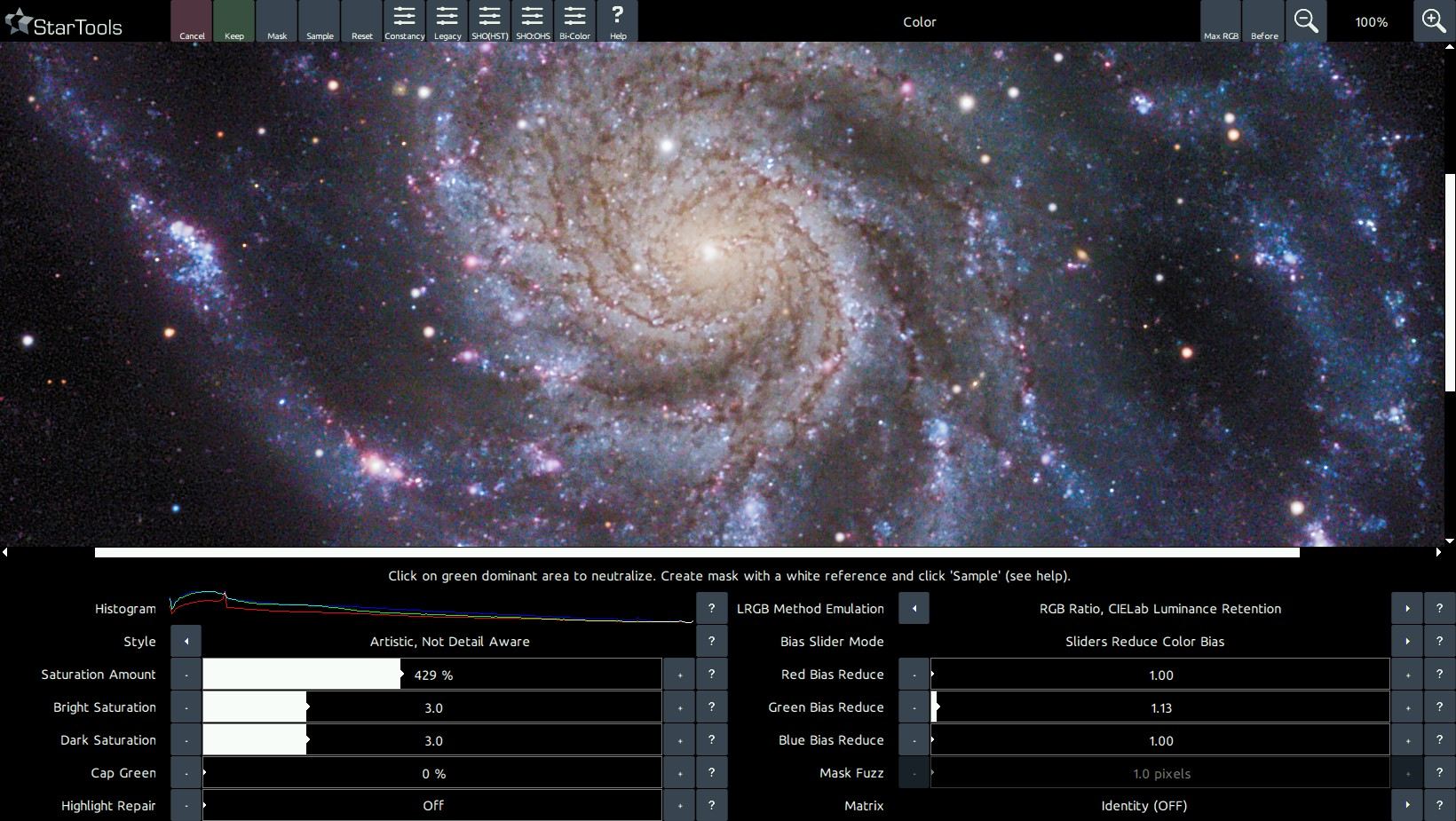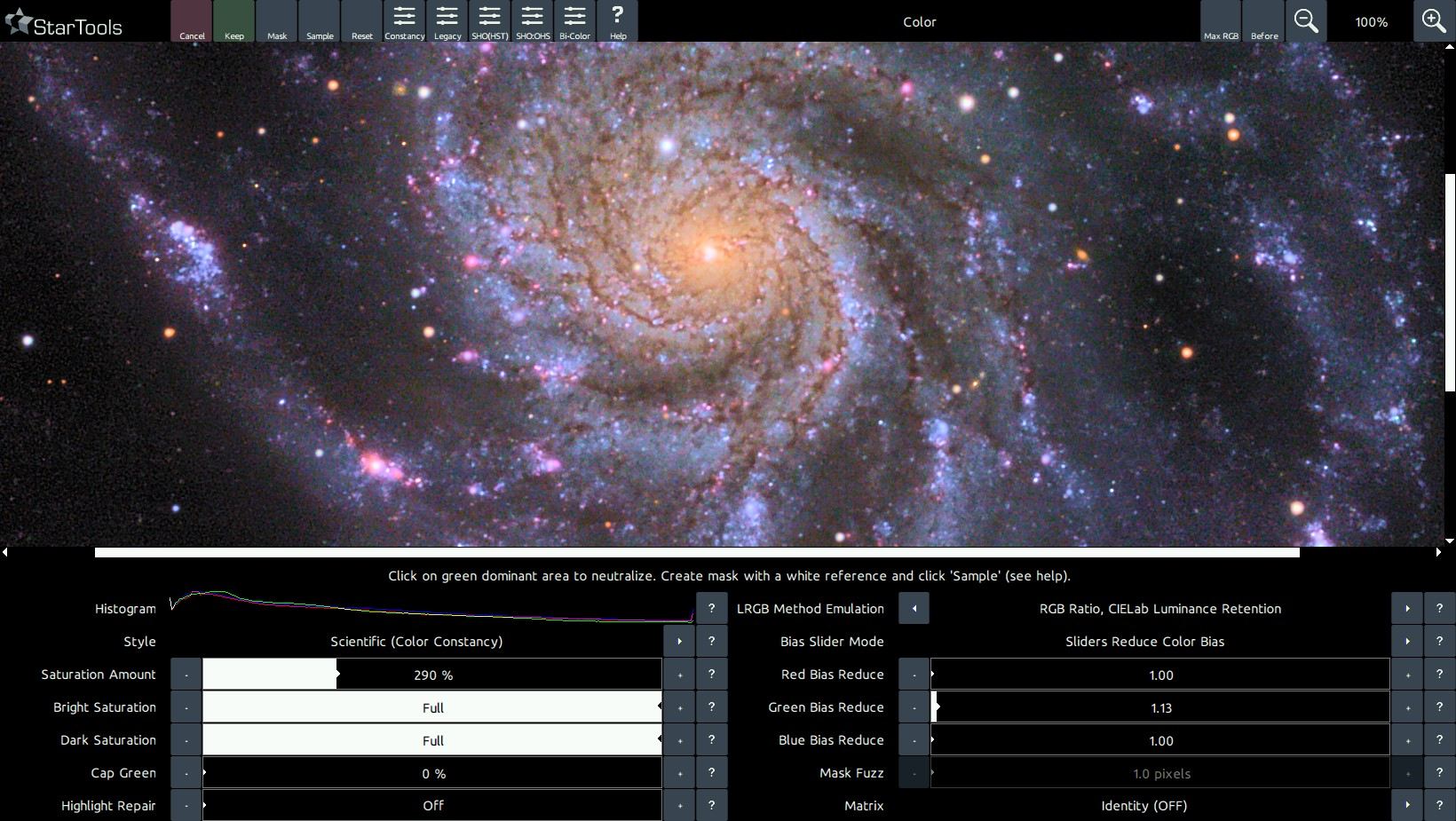- Usage
- Tweaking your colours
Tweaking your colors

Once you have achieved a color balance you are happy with, the StarTools Color module offers a great number of ways to change the presentation of your colours.
Style
The parameter with the biggest impact is the 'Style' parameter. StarTools is renowned for its Color Constancy feature, rendering colours in objects regardless of how the luminance data was stretched, the reasoning being that colours in outer space don't magically change depending on how we stretch our image. Other software sadly lets the user stretch the colour information along with the luminance information, warping, distorting and destroying hue and saturation in the process. The 'Scientific (Color Constancy)' setting for Style undoes these distortions using Tracking information, arriving at the colours as recorded.
To emulate the way other software renders colours, two other settings are available for the 'Style' parameter. These settings are "Artistic, Detail Aware" and "Artistic, Not Detail Aware". The former still uses some Tracking information to better recover colours in areas whose dynamic range was optimised locally, while the latter does not compensate for any distortions whatsoever.
LRGB Method Emulation
The 'LRGB Method Emulation' parameter allows you to emulate a number of colour compositing methods that have been invented over the years. Even if you acquired data with an OSC or DSLR, you will still be able to use these compositing methods; the Color module will generate synthetic luminance from your RGB on the fly and re-composite the image in your desired compositing style.
The difference in colouring can be subtle or more pronounced. Much depends on the data and the method chosen.
- 'Straight CIELab Luminance Retention' manipulates all colours in a psychovisually optimal way in CIELab space, introducing colour without affecting apparent brightness.
- 'RGB Ratio, CIELab Luminance Retention' uses a method first proposed by Till Credner of the Max-Planck-Institut and subsequently rediscovered by Paul Kanevsky, using RGB ratios multiplied by luminance in order to better preserve star colour. Luminance retention in CIELab color space is applied afterwards.
- '50/50 Layering, CIELab Luminance Retention' uses a method proposed by Robert Gendler, where luminance is layered on top of the colour information with a 50% opacity. Luminance retention in CIELab color space is applied afterwards. The inherent loss of 50% in saturation is compensated for, for your convenience, in order to allow for easier comparison with other methods.
- 'RGB Ratio' uses a method first proposed by Till Credner of the Max-Planck-Institut and subsequently rediscovered by Paul Kanevsky, using RGB ratios multiplied by luminance in order to better preserve star colour. No further luminance retention is attempted.
- '50/50 Layering, CIELab Luminance Retention' uses a method proposed by Robert Gendler, where luminance is layered on top of the colour information with a 50% opacity. No further luminance retention is attempted. The inherent loss of 50% in saturation is compensated for, for your convenience, in order to allow for easier comparison with other methods.

When processing a complex composite that carries a luminance signal that is substantially decoupled from the chrominance signal (for example importing H-alpha as luminance and a visual spectrum dataset as red, green and blue via the Compose module), then the 'RGB Ratio, CIELab Luminance Retention' will typically do a superior job accommodating the greater disparities in luminance and how this affect final colouring.
Finally, please note that the LRGB Emulation Method feature is only available when Tracking is engaged.
Saturation
The 'Saturation' parameter allows colours to be rendered more, or less vividly, whereby the 'Bright Saturation' parameter and 'Dark Saturation' parameter control how much colour and saturation is introduced in the highlights and shadows respectively. It is important to note that introducing colour in the shadows may exacerbate colour noise, though Tracking will make sure any such noise exacerbations are recorded and dealt with during the final denoising stage.
Cap Green
The 'Cap Green' parameter, finally, removes spurious green pixels if needed, reasoning that green dominant colours in outer space are rare and must therefore be caused by noise. Use of this feature should be considered a last resort if colour balancing does not yield adequate results and the green noise is severe. The final denoising stage should, thanks to Tracking data mining, pin pointed the green channel noise already and should be able to adequately mitigate it.
You may also be interested in...
- Complex LLRGB composites made easy (under Tutorial videos)
The workflow details the usual data prep, bias/gradient removal, stretching, deconvolution, color calibration and noise reduction.
- Matrix correction and on-the-fly channel remapping (under Usage)
This helps improve luminance (detail) signal, by not contaminating it with cross-channel camera-space RGB and XYZ-space manipulations.
- Usage (under Crop)
A 'Color'/'NBAccent' button is available, which functions much like the 'Color'/'NBAccent' button in the Wipe module.
- Crop: Express Cropping Tool with Switchable Luminance, Chrominance and Narrowband Accent Previewing (under Features & Documentation)
- Stage 1: Signal stretch and contribution calibration (under Usage)
It is important to understand that the signal as show during this first stage, is merely signal that is up for consideration by the second stage.
